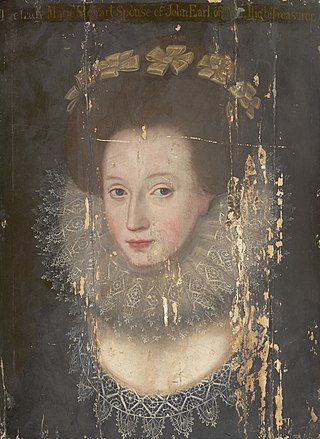Related Research Articles

John Erskine, 2nd Earl of Mar was a Scottish politician, the only son of another John Erskine and Annabella Murray. He is regarded as both the 19th earl and the 2nd earl.
A maid of honour is a junior attendant of a queen in royal households. The position was and is junior to the lady-in-waiting. The equivalent title and office has historically been used in most European royal courts.
William Fowler was a Scottish poet or makar, writer, courtier and translator.

Robert Strelley, of Great Bowden, Leicestershire, was an English politician, soldier, and courtier to Mary I of England.
Lady Audrey Walsingham was an English courtier. She served as Lady of the Bedchamber to queen Elizabeth I of England, and then as Mistress of the Robes to Anne of Denmark from 1603 until 1619.

Marie Stewart, Countess of Mar (1576-1644) was a Scottish courtier. She was the daughter of Esmé Stewart, 1st Duke of Lennox, a favourite of James VI of Scotland, and Catherine de Balsac. After her marriage, as was customary in Scotland, she did not change her name, and signed her letters as "Marie Stuart".

Frances Howard, Countess of Kildare, was a courtier and governess of Princess Elizabeth Stuart, Queen of Bohemia, and a member of the House of Howard.
Barbara Ruthven was a Scottish courtier and favourite of Anne of Denmark, expelled from court after the death of her brother.
Mary Middlemore was a Courtier and Maid of Honour to Anne of Denmark, subject of poems, and treasure hunter.
Elizabeth Roper was a member of the household of Anne of Denmark. She married Robert Mansell, a glass-making entrepreneur and became involved in his business. She was noted for her business activities as a "capitalist" by the historian Alice Clark.
Mary Gargrave was a courtier to Anne of Denmark.

Elizabeth Howard (1564—1646) was an English aristocrat and courtier to Elizabeth I of England.
Mary Woodhouse, Lady Killigrew, musician and correspondent of Constantijn Huygens, was the daughter of Henry Woodhouse (MP) of Hickling and Waxham, and Anne Bacon, daughter of Sir Nicholas Bacon. She may have been the "Woodhouse" appointed Maid of Honour to Anne of Denmark in December 1603.

Dr Martin Schöner or Schönerus, physician to James VI and I and Anne of Denmark.

Anne Sutton was an English lady-in-waiting who was a companion of Elizabeth Stuart, Queen of Bohemia. She was the daughter of Edward Sutton, 5th Baron Dudley and Theodosia Harington. Sutton was known as "Mrs Anne Dudley" or "Mistress Dudley" although "Sutton" was the family surname. Elizabeth of Bohemia called her "Nan Duddlie".

Anne Killigrew was a Lady in Waiting to Queen Henrietta Maria, and the first wife of George Kirke who was Groom of the Chamber to Charles I of England.

The coronation of James I and his wife Anne as King and Queen of England and Ireland was held on 25 July 1603 at Westminster Abbey. James had reigned as King James VI of Scotland since 1567. Anne was anointed and consecrated with prayers alluding to Esther, the Wise Virgins, and other Biblical heroines. It was the first coronation to be conducted in English instead of Latin. A planned ceremonial Royal Entry to London was deferred until 15 March 1604.

The coronation of Mary I as Queen of England and Ireland took place at Westminster Abbey, London, on Sunday 1 October 1553. This was the first coronation of a queen regnant in England, a female ruler in her own right. The ceremony was therefore transformed. Ritual and costume were interlinked. Contemporary records insist the proceedings were performed "according to the precedents", but mostly these were provisions made previously for queens consort.
A chamberer was a female attendant of an English queen regnant, queen consort, or princess. There were similar positions in aristocratic households.
Anne Poyntz was an English courtier.
References
- ↑ Agnes Strickland, Lives of the Queens of England, vol. 6 (Philadelphia, 1847), p. 310: William John Thoms, The Book of the Court: Exhibiting the History, Duties, and Privileges of the several ranks of the English nobilty (London: Bohn, 1844), p. 350.
- ↑ Henry King, 'Ancient Wills, 3', Transactions of the Essex Archaeological Society, 3 (Colchester, 1865), p. 187.
- ↑ William Tighe, 'Familia reginae: the Privy Court', Susan Doran & Norman Jones, The Elizabethan World (Routledge, 2011), pp. 76, 79.
- ↑ James Gairdner & R. H. Brodie, Letters & Papers Henry VIII, vol. 15 (London, 1896), p. 9 no. 21.
- ↑ David Loades, Mary Tudor: A Life (Oxford, 1992), p. 355.
- ↑ The Manuscripts of S. H. Le Fleming, Esq., of Rydal Hall, HMC volume 12, Part 7 (London, 1890), pp. 9-10.
- ↑ Jane Lawson, 'Ritual of the New Year's Gift', Valerie Schutte & Jessica S. Hower, Mary I in Writing: Letters, Literature, and Representation (Palgrave Macmillan, 2022), p. 181.
- ↑ Janet Arnold, 'Coronation Portrait of Queen Elizabeth I', Burlington Magazine, 120 (1978), p. 738.
- ↑ Jane Lawson, 'Ritual of the New Year's Gift', Valerie Schutte & Jessica S. Hower, Mary I in Writing: Letters, Literature, and Representation (Palgrave Macmillan, 2022), p. 180.
- ↑ HMC 6th Report: Moray (London, 1877), p. 672
- ↑ Linda Levy Peck, Court Patronage and Corruption in Early Stuart England (London, 1990), p. 69: Edmund Lodge, Illustrations of British History, vol. 3 (London, 1791), p. 228.
- ↑ Nadine Akkerman, 'The Goddess of the Household: The Masquing Politics of Lucy Harington-Russell, Countess of Bedford', The Politics of Female Households: Ladies-in-waiting across Early Modern Europe (Leiden, 2014), p. 307.
- ↑ Caroline Hibbard, 'Henrietta Maria in the 1630s', Ian Atherton & Julie Sanders, The 1630s: Interdisciplinary Essays on Culture and Politics in the Caroline Era (Manchester, 2006), p. 104.
- ↑ Henry B. Wheatley, The Diary of Samuel Pepys, vol. 2 (New York: Random House), p. 1027: John Stow, A survey of the cities of London and Westminster, vol. 2 (London, 1753), p. 574.